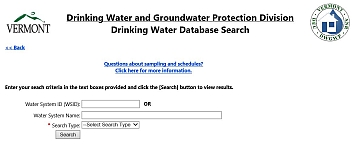PFAS Drinking Water Data
Data are received and updated on a periodic basis when they are received from the laboratories.
- Statewide PFAS Monitoring Results Received (NOTE: May take a minute or two depending on your internet speeds)
- Search for PFAS Monitoring Results by Water System
- Imported Bottled Water Systems: PFAS Monitoring Results Received
Required Water Quality Monitoring for PFAS
UPDATE: Public Drinking water systems may now submit PFAS data from certified laboratories performing US EPA Method 533. See the Secretary’s approval letter.
PFAS monitoring has been added to routine monitoring schedules and water systems must sample according to their monitoring schedule. The entry point to distribution is where PFAS samples must be collected. The entry point is the same sampling point where the system routinely collects IOCs, VOCs, SOCs, Nitrate, or Radionuclide samples. If water is drawn from more than one source and the sources are combined before distribution, a sample shall be collected at an entry point to the distribution system where water is representative of all permitted sources supplying that entry point. If a water system has multiple entry points, this will be reflected on the system’s monitoring schedule. Monitoring schedules and further sampling point guidance can be found on the Drinking Water Database Search page. Composite sampling among multiple entry points is not allowed.
Samples must be submitted to a laboratory that is certified by the Vermont Department of Health for analysis of drinking water in Vermont. The current list of certified laboratories can be found on the Department of Health's Laboratories Certified for Drinking Water Analysis document.. The water system will be responsible to coordinate with the laboratory to ensure samples can be analyzed within the method hold time, and reported promptly to the Division.
Monitoring requirements will be determined as follows:
- If annual PFAS sample is non-detect (i.e. ND or < 2.0 ng/L) for all 5 regulated PFAS compounds, sampling may be decreased to once every 3 years. Furthermore, if 2 consecutive 3-year monitoring results indicate non-detects, sampling frequency may be decreased to once every 6 years.
- If regulated PFAS are detected at or above 2 ng/L but less than 15 ng/L, annual monitoring continues. If regulated PFAS are detected above 15 ng/L, quarterly monitoring will be required.
- If regulated PFAS are detected above 20 ng/L, quarterly monitoring and a confirmation sample is required.
If regulated PFAS are confirmed above 20 ng/L or detected above 40 ng/L in a single sample, an immediate Do Not Drink notice will be required.
Please submit all water quality monitoring data electronically to ANR.DWdata@vermont.gov


